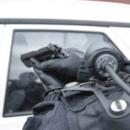
In recent years law enforcement agencies have been experimenting with and using body-worn video cameras. How future cameras can be improved to further officer safety and effectiveness was among the topics discussed at a technology institute sponsored by the Office of Justice Programs’ National Institute of Justice (NIJ).
Proponents of body-worn cameras say they protect officers from false accusations, reduce agency liability and citizen complaints, and provide evidence for use in court. Unlike vehicle-mounted cameras, the body-worn cameras travel with the officer when he steps away from the patrol car. They can be attached to a shirt pocket, helmet, glasses or badge, and can serve to augment in-car video systems or provide an option to the expensive in-car systems that some departments cannot afford.
Capt. Wayne Hoss of the San Mateo Police Department says that while those arguments carry weight, the current technology has limitations. Why not go further and incorporate technology into body-worn cameras that could substantially increase officer safety?
Hoss discussed the current state of body-worn cameras and a future vision for the technology at the NIJ 2013 Technology Institute for Law Enforcement.
San Mateo, with a population of approximately 98,000, sits about 20 miles south of San Francisco, near Silicon Valley, which is home to numerous established and start-up high-tech companies. The police department has 100 sworn officers.
Hoss says the proximity to the technology enclave has served the police department well, affording it the opportunity to serve as a testing ground for new technologies, such as a WiFi network that provides officers in the field with wireless broadband access to law enforcement databases. […]
Source: policeone.com
